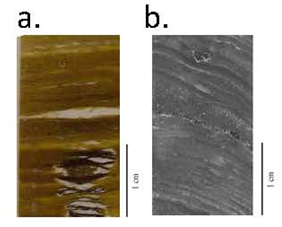Varves
varves[edit | edit source]
An example of biological–chemical varve formation from predominantly autochthonous sediments is found in Lake Seeberg, Switzerland, where two diatom blooms and carbonate precipitation form annual laminae (Fig. 1a). An example of mineral varve formation from allochthonous sediments is found in glacial-fed Lake Silvaplana, Switzerland, where seasonal peaks of glacial runoff transport clastic material into the lake, forming a layer of coarser-grained light-colored sediments during the summer. During the winter, when the lake is calm as a result of ice cover, finer-grained dark-colored sediments are deposited (Fig. 1b).
Varves are relevant for climate sciences because they permit high-resolution (i.e., subannual–annual) measurements of changes in the thickness and composition of sediment. These sedimentary changes reflect conditions in the lake and marine environment, as well as the greater catchment, which are often driven by climate and weather events. Therefore, varves are recognized as a valuable archive of past climate and weather.
Fig. 1. Thin section of varved sediments recovered from (a) Lake Seeberg and (b) Lake Silvaplana, both in Switzerland. Note that (b) is in grayscale. [From Stewart (2011).]
Stewart, M., 2011: High-resolution, multi-proxy climate reconstructions of the late Holocene derived from the varved sediments of two lakes in the Swiss Alps. Ph.D. thesis, University of Bern, 179 pp. [Available online at http://csold.unibe.ch/students/theses/phd/70.pdf.]
Zolitschka, B., P. Francus, A. E. K. Ojala, and A. Schimmelmann, 2015: Varves in lake sediments—A review. Quat. Sci. Rev., 117, 1–41, doi:10.1016/j.quascirev.2015.03.019.
Term edited 18 August 2016.

